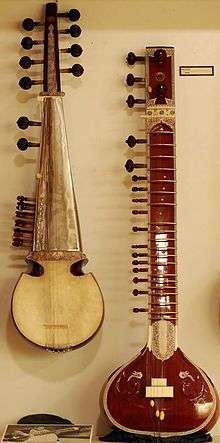Pakhavaj
The pakhavaj is a barrel-shaped, two-headed drum, originating from the Indian subcontinent,[1] a variant and descendant of the older mridang.
| Percussion instrument | |
|---|---|
| Developed | 14th century, during Mughal period |
| Related instruments | |
| mridang, khol, tabla | |
| More articles or information | |
| Hindustani music | |
It is the standard percussion instrument in the dhrupad style and is used as an accompaniment for various forms of music and dance performances. The pakhavaj has a low, mellow tone, which is very rich in harmonics. Set horizontally on a cushion in front of the drummer's crossed leg, the larger bass-skin is played with the left hand, the treble skin by the right hand. The bass face is smeared with wet wheat dough which acts as the kiran and is the cause of the vivid bass sound the pakhavaj produces.
The Pakhawaj is tuned like the tabla, with wooden wedges that are placed under the tautening straps. The fine tuning is done on the woven outer ring which is part of the skin. The bass skin is traditionally prepared for playing by applying a freshly made batter of flour and water in order to receive its low-pitched sound.[2]
Etymology
The word pakhāvaja or pakhavāja is of Prakrit origin, whose Sanskrit equivalent is pakṣavādya. This word is derived from the words pakṣa ("a side"), and vādya ("a musical instrument"). It is said that, during the 14th century, the great mridangists experimented with the materials used in mridang construction, and finally started using wood for the main body as opposed to the original clay. Thus, a new name pakhawaj emerged, whilst the older name, mridang was still used.[3]
Technique
As with the tabla, the pakhavaj rhythms are taught by a series of mnemonic syllables known as bol. The playing technique varies from that of tabla in many aspects: in the bass face, the artist hits with his whole palm instead of the finger tip hitting which is done in tabla. In the treble face, the artist hits his whole palm with the fingers properly placed on the skin to produce different bols.
In traditional pakhavaj styles a student would learn a number of different strokes which produce a specific sound. These are remembered and practiced with corresponding syllables.
A very basic capacity is to play a theka in a particular tala or rhythmic cycle, as for instance chautala, unrelated to chowtal, a folksong in the Bhojpuri region, in 12 beats:
| dha dha | din ta || kite dha | din ta | tite kata | gadi gene |
Advanced students learn relas that are virtuoso pakhavaj compositions.
References
- James Blades (1992). Percussion Instruments and Their History. Bold Strumme. pp. 138–. ISBN 978-0-933224-61-2. Retrieved 25 December 2012.
- Pakhavaj, Tuning. "Tuning Pakhavaj". http://www.indian-instruments.com. (N.A.). Retrieved (N.A.). Check date values in:
|accessdate=(help); External link in|website=(help) - Sir Ralph Lilley Turner (1975). Collected papers, 1912-1973. Oxford University Press. Retrieved 25 December 2012.
